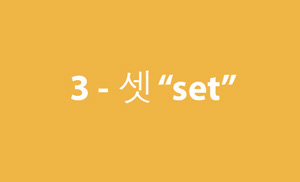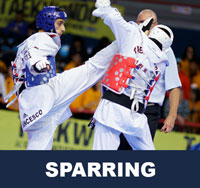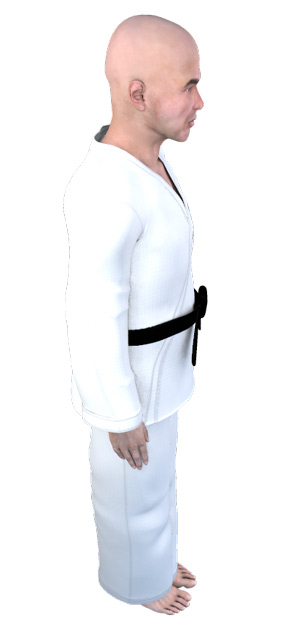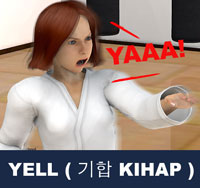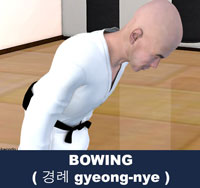Taekwondo 태권도Taekwondo Preschool
Promotion from one geup to the next can proceed rapidly in some schools, since schools often allow geup promotions every two, three, or four months. Students of geup rank learn the most basic techniques first, and then move on to more advanced techniques as they approach first dan. Many of the older and more traditional schools often take longer to allow students to test for higher ranks than newer, more contemporary schools, as they may not have the required testing intervals. View Taekwondo belt levels »
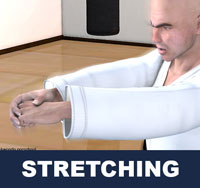
Stretching
( 스트레칭 seuteuleching )
Sports injuries are injuries that occur in athletic activities. They can result from acute trauma, or from overuse of a particular body part. Please see a certified specialist or doctor for sports injuries. Proper guidance and instructions are needed from a certified Master Instructor ( 사범님 sabeomnim ) to ensure safe training.
Stretching ( 스트레칭 seuteuleching ) is a form of physical exercise in which a specific muscle or tendon (or muscle group) is deliberately flexed or stretched in order to improve the muscle's felt elasticity and achieve comfortable muscle tone. The result is a feeling of increased muscle control, flexibility and range of motion. Stretching is also used therapeutically to alleviate cramps.
In its most basic form, stretching is a natural and instinctive activity; it is performed by humans and many other animals. It can be accompanied by yawning. Stretching often occurs instinctively after waking from sleep, after long periods of inactivity, or after exiting confined spaces and areas. Increasing flexibility through stretching is one of the basic tenets of physical fitness. It is common for athletes to stretch before and after exercise in order to reduce injury and increase performance.
Stretching can be dangerous when performed incorrectly. There are many techniques for stretching in general, but depending on which muscle group is being stretched, some techniques may be ineffective or detrimental, even to the point of causing permanent damage to the tendons, ligaments and muscle fiber. The physiological nature of stretching and theories about the effect of various techniques are therefore subject to heavy inquiry.
* Please see a certified Master Instructor ( 사범님 sabeomnim ) for training. Proper guidance and instructions are needed to ensure safe training.
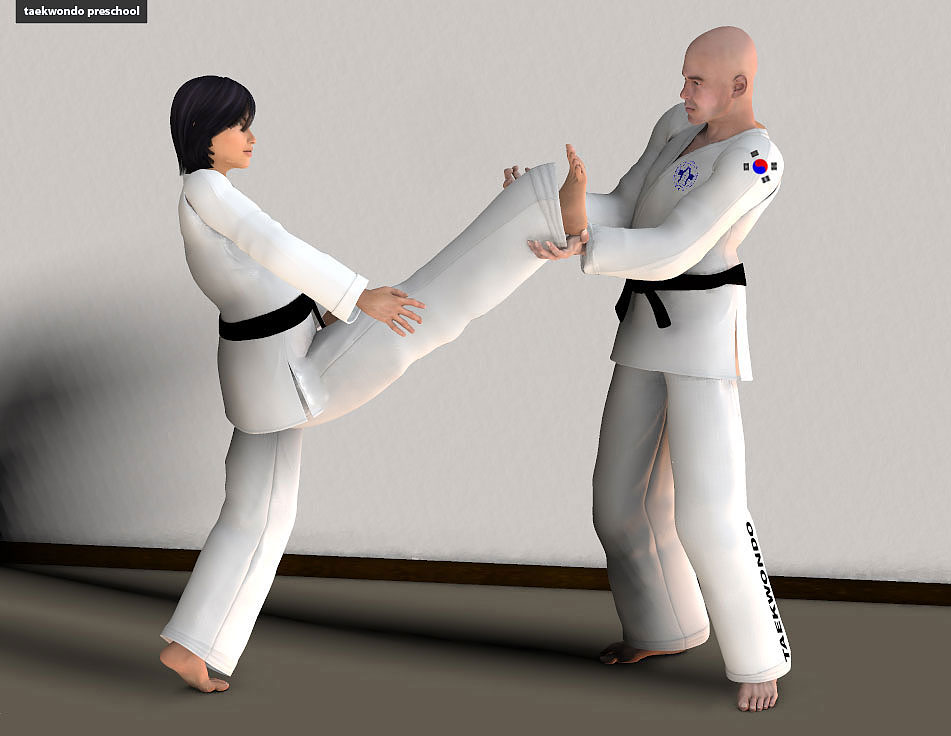
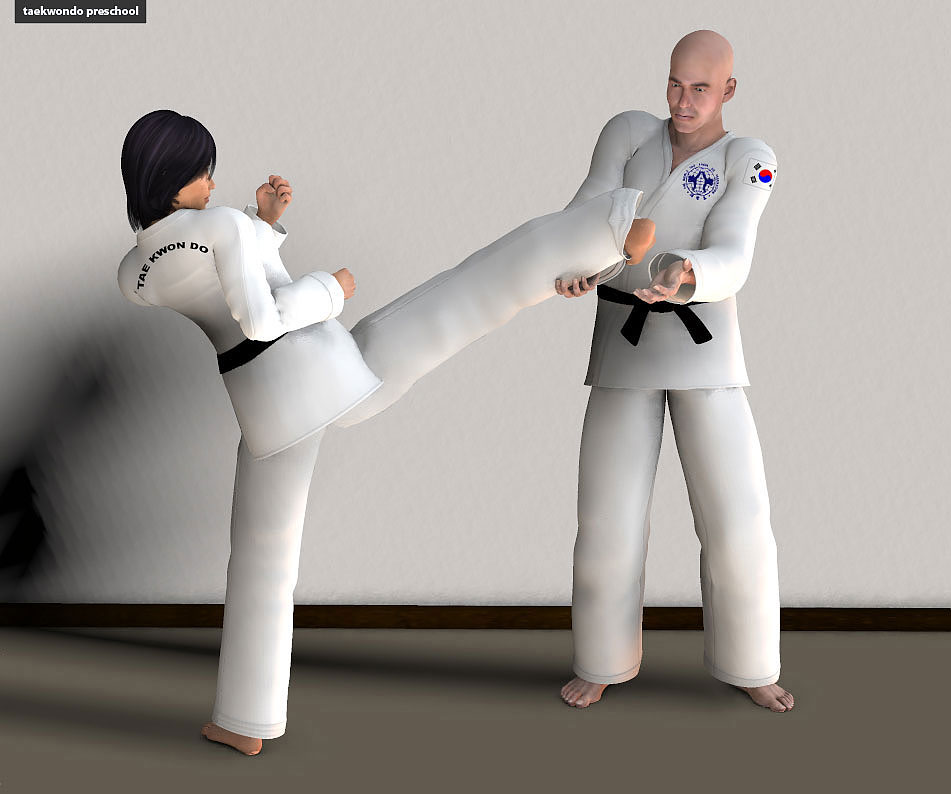
Benefits
One review suggests that there are many beneficial stretches that can improve range of motion (ROM) in athletes, especially runners. It is also suggested that one stretching exercise may not be enough to prevent all types of injury, and that, multiple stretching exercises should be used to gain the full effects of stretching. It has also been suggested that proprioceptive neuromuscular facilitation (PNF) stretching yields the greatest change in range of motion, especially short-term benefits. Reasoning behind the biomechanical benefit of PNF stretching points to muscular reflex relaxation found in the musculotendinous unit being stretched. Others suggest that PNF benefits are due to influence on the joint where the stretch is felt.
If done properly, stretching can prevent injury, relax the muscles, increase range of motion and flexibility, and better one's performance, especially athletes. Although stretching does not prevent injury, it can reduce the risk greatly; especially if one stretches properly and on a regular basis. Stretching is more beneficial to those who stretch regularly, as opposed to those people who stretch occasionally. Stretching increases blood flow which prevents hardening of the arteries and it also produces synovial fluid, which lubricates the joints that are surrounded by the muscles; which in turn helps prevent arthritis. Stretching stabilizes the body's natural balance and posture, and aligns the joints leading to better coordination. After any physical activity, there is a buildup of lactic acid in one's body and by stretching the lactic acid is removed, therefore alleviating any muscle pain or cramps. It is important for a person to perform each of the four types of stretching properly to gain the benefits. It has been shown for example that intensive stretching has a synergistic effect with Plyometric training by protecting the joint and making it more receptive to the benefits of the plyometric drills.
Types of Stretches
There are four different types of stretching: ballistic, dynamic, passive stretching (proprioceptive neuromuscular facilitation), and static stretching. Ballistic stretching is a rapid bouncing stretch in which a body part is moving with momentum that stretches the muscles to a maximum. Muscles respond to this type of stretching by contracting to protect itself from over extending. Dynamic stretching is a walking or movement stretch. By performing slow controlled movements through full range of motion, a person reduces risk of injury. Proprioceptive neuromuscular facilitation (PNF) is a type of stretch for a particular muscle and its specific job, so resistance should be applied, then the muscle should be relaxed. Static stretching is a type of stretch whereby a person stretches the muscle until a gentle tension is felt and then holds the stretch for thirty seconds or until a muscle release is felt, without any movement or bouncing.
- Static stretching is used to stretch muscles while the body is at rest. It is composed of various techniques that gradually lengthen a muscle to an elongated position (to the point of discomfort) and hold that position for 30 seconds to two minutes. 30 seconds is the minimum duration to get the benefits of stretching, whereas two minutes is the maximum (if a position can be held for more than two minutes, a farther stretch should be performed). During this holding period or directly afterwards, participants may feel a mild discomfort or warm sensation in the muscles. Static stretching exercises involve specialized tension receptors in our muscles. When done properly, static stretching slightly lessens the sensitivity of tension receptors, which allows the muscle to relax and to be stretched to greater length.
- Dynamic stretching is a form of stretching beneficial in sports utilizing momentum from form, static-active stretching strength and the momentum from static-active stretching strength, in an effort to propel the muscle into an extended range of motion not exceeding one's static-passive stretching ability. Anything beyond this range of motion becomes ballistic stretching. It is a type of stretching while moving.
- Ballistic stretching is a form of passive stretching or dynamic stretching in a bouncing motion. According to the American Academy of Orthopedic Surgeons; "Do not bounce your stretches. Ballistic (bouncy) stretching can cause injury." -- "American Academy of Orthopedic Surgeons - Flexibility Exercises". Ballistic stretches force the limb into an extended range of motion when the muscle has not relaxed enough to enter it. It involves fast "bouncing" movements where a double bounce is performed at the end range of movement.
- Passive stretching is a form of static stretching in which an external force exerts upon the limb to move it into the new position. This is in contrast to active stretching. Passive stretching resistance is normally achieved through the force of gravity on the limb or on the body weighing down on it. It can also be achieved with the help of a partner, stretch bands, or mechanical devices. The more force exerted on the limb, the less time it will take to drop lower into the stretch.
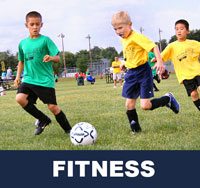
Related Articles
Physical fitness is a general state of health and well-being or specifically the ability to perform aspects of sports or occupations. It is a set of attributes or characteristics that people have or achieve that relates to the ability to perform physical activity. View Physical Fitness »
- Stretch - Form of physical exercise in which a specific muscle or tendon (or muscle group) is deliberately flexed or stretched in order to improve the muscle's felt elasticity and achieve comfortable muscle tone. The result is a feeling of increased muscle control, flexibility and range of motion.
- Flexibility - Refers to the absolute range of movement in a joint or series of joints, and length in muscles that cross the joints. Flexibility in some joints can be increased to a certain degree by exercise, with stretching a common exercise component to maintain or improve flexibility.
- Endurance - Ability of a practitioner to exert itself and remain active for a long period of time, as well as its ability to resist, withstand, recover from, and have immunity to trauma, wounds, or fatigue.
- Balance - Ability to maintain the line of gravity (vertical line from centre of mass) of a body within the base of support with minimal postural sway. Sway is the horizontal movement of the centre of gravity even when a person is standing still.
- Agility - Or nimbleness is the ability to change the body's position efficiently, and requires the integration of isolated movement skills using a combination of balance, coordination, speed, reflexes, strength, and endurance.
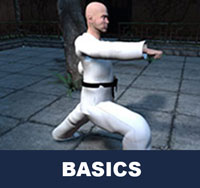
Taekwondo Basics
Here is where you can learn more about Taekwondo 태권도. Knowing the fundamental basics is very important for your learning path as you build your skills and knowledge. There are certain rules that need to be followed to show respect to the master ( 사범님 sabeomnim ), the instructors ( 교사님 gyosannim ), other practitioners and to the martial arts. They vary between schools but many have similar rules and guidelines. For more information View Taekwondo Basics »
Please follow the guidance of a certified Master Instructor or trainer when doing sports related activities. The article provided on this page is information that is widely available on Wikipedia articles "Stretching", "Static Stretching", "Dynamic Stretching", "Ballistic Stretching". Risk of injury can be reduced by completing an effective warm up consisting of a heart raiser to get your pulse up, followed by sport specific dynamic stretches (stretches whilst moving).
RESOURCES
This article uses material from the Wikipedia articles "Stretching", "Static Stretching", "Dynamic Stretching", "Ballistic Stretching", which is released under the Creative Commons Attribution-Share-Alike License 3.0.





